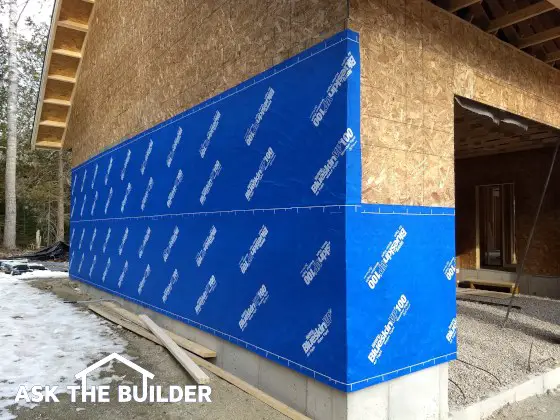Sticky House Wrap and Squirrels in Attics

This is a marvelous newer full-adhesion house wrap. Installed correctly, you’ll discover your heating and cooling bills will be much lower. (C) Copyright 2019 Tim Carter
Sticky House Wrap
QUESTION #1: Tim, I’m building a new home and the builder wants to apply an exterior house wrap that reminds me of adhesive shelf paper. All the other house wraps I’ve seen come in large rolls and are nailed to the house. I’m afraid the adhesive house wrap might not stand the test of time. How do you feel about these self-adhering house wraps and what’s involved in getting it installed correctly? Pam T., Lexington, KY
You may be building a new home like Pam or having a room addition put onto your home. Self-adhering house wraps are a great refinement over the first-generation house wraps that require nails. I would absolutely use a self-adhering house wrap on a new house I’d build for myself, a family member, or a customer.
There are several manufacturers of the self-adhering house wraps. All the products are fabulous and it’s quite hard to differentiate them from one another. As with many things in construction, the devil is in the details. You can have a great product and it can be installed incorrectly thus voiding the warranty and causing nightmares down the road for the homeowner.
I witnessed a builder this past winter who did just that. He decided to use a traditional nail-on house wrap but used a hand tacker tool that pounds hundreds of small staples through the house wrap into the wood wall sheathing. The issue is the staples are an unapproved fastener and they actually create tiny holes around each staple that can leak both water and air.
The newer self-adhered house wraps won’t allow liquid water to touch the wood framing, but they allow water vapor in the wall assembly to pass through to the atmosphere. This is exactly what you want.
I’m attracted to the newer house wraps that have the adhesive because they do a superb job of bridging any gaps in the wall sheathing and virtually eliminate air infiltration into a house. Air infiltration is a major cause of higher fuel bills for both heating and air conditioning.
It’s very important for you, the homeowner, to read the simple installation instructions for the self-adhering house wrap you decide to use. The instructions are simple and not at all complex. Some products can be installed horizontally or vertically. I’d recommend a horizontal installation starting at the bottom of the structure. Be sure you overlap the next higher piece no less than 2 inches or whatever the instructions say to do.
Most products have great instructions how to deal with pipe and duct penetrations on the outside walls. You also need to follow the instructions with respect to how to apply the overlapping pieces of the house wrap around all windows and doors.
Some of the products require the use of a j-roller that works just like a giant steamroller that compresses asphalt paving on roads and driveways. The j-roller ensures the house wrap adhesive is in great contact with the wood wall sheathing.
Pay very close attention in the written instructions or videos about how to flash underneath all windows and doors. You need to inspect these openings to ensure it’s been done correctly. If you can’t be there, then insist the builder take photos with his smart phone of every window and door and send them to you so you can verify the job was done correctly.
Squirrels In Attics
QUESTION #2: Last night I came face-to-face with a squirrel up in my attic. I was astonished at his presence and wondered how he gained entrance. I looked at my roof and saw my ridge vent was higher in one spot. I had the ridge vent put in when I re-roofed the house thinking it would be a benefit to the traditional triangle gable-end vents that have worked well for 50 years. What’s the best way to stop the squirrel from becoming a permanent resident in my attic? I’m open to any and all suggestions. Chris A., Arab, AL
Animals of all sorts try to get into house attics. A few years ago, I had at my own home an infestation of flying squirrels in my attic. At night the little devils would roll acorns across my bedroom ceiling like they were bowling. It was infuriating. I solved my problem when I re-roofed my home by sealing off the entrances with heavy metal.
My advice to Chris, or you should you have the same issue, is to get rid of the ridge vent. I’d get a 10-inch-wide piece of heavy aluminum coil stock that siding contractors use. This would cover over the cut-out made for the ridge vent. Nail it securely over the shingles at the peak of the roof every 6 inches.
I’d then cover over the aluminum with standard asphalt cap shingles to match the current roofing. Since cap shingles are 12 inches wide, they’ll fully cover the aluminum so you’ll never see it. The squirrels will have to chew through the shingles only to encounter the thick aluminum. I’m quite sure they’ll give up and go to your neighbor’s home where it’s easier to get into the attic.
I happen to love turbine vents. I’d consider adding two or three on the back of your home up near the peak of the roof. Be sure you can’t see the spinning whirlybirds from the front yard or the street. Squirrels don’t like the spinning motion of these great wind-powered ventilators and you should have no issues at all in the future.
Column 1296